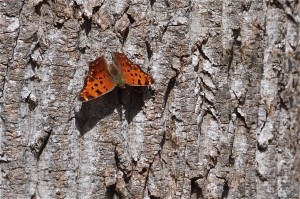It was a beautiful sunny warm day to be out looking for butterflies on Sunday afternoon, May 4, and Cedarock Park in southern Alamance Co. south of Burlington, NC, looked like a great place to find them. The park features a variety of good butterfly habitats, including meadows, woodlands, pond edges, and a pretty little creek, usually with many nectar flowers. Unfortunately, the butterflies didn’t agree; we saw only five species!
No doubt the lack of butterflies was due to another species that was abundant throughout the park: humans. The park had recently been mowed and raked right up to the edges of the woods and ponds to the extent that there were almost no nectar flowers in sight anyplace.
Probable reasons for the close grooming of the park grounds became obvious quickly. The park was quite crowded. There was some sort of music event near an outdoor stage, and what appeared to be a disc golf tournament was going on with several teams of four flinging their discs long distances over much of the meadows. Folks not involved in either of those activities were gathered around the pond fishing or occupying the picnic shelters.
After about an hour and a half of walking along the woodland edges and around the pond, our butterfly group decided to give up. As several of us agreed, any day you’re outside in such fine weather is a good day, so at least we got to enjoy a nice walk in the park.
Those of us trying to learn dragonflies saw Common Baskettail, Lancet Clubtail, Blue Corporal, Common Whitetail, and Green Darner near the pond. That’s one more species of dragonfly than our total for butterflies!
The few butterflies we saw mostly were in flight (looking for nectar flowers, probably). We noted one (possibly two) Eastern Tiger Swallowtail, two yellows that probably were Orange Sulphurs, one Pearl Crescent, and one Silvery Checkerspot. The one butterfly species that was reasonably abundant was Carolina Satyr, since it’s a woodland species unaffected by the recent mowing. We saw 8+ of that species.
Dennis
—
Dennis E. Burnette
Greensboro, NC 27410
deburnette@triad.rr.com

